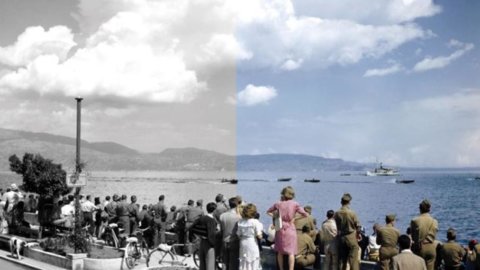A long sigh of relief, shared by Italian civilians and soldiers with the allied armies and partisans, accompanies the end of the Second World War. It is a moment of celebration and hope and, at the same time, a moment of fear, contrasts and bewilderment: between the end of April and the beginning of May 1945, the new Italy has yet to be fulfilled and the country, destroyed and starving, struggles for redemption, towards rebirth.
Through the selection of about 140 images, even unpublished, and period films – between July 1943 (the Allied landings in Sicily) and 1946 – the narrative of the war takes place through its protagonists, Italians and Americans, and the unique and evocative confrontation between two different points of view.
On the one hand the shots of the Istituto Luce, the official organ of photo-cinematographic documentation of the regime, where the "black and white" it is expression before the grim decline of fascism and then the sobriety of a ruling class trying to build on the ruins of war; among these, many images of the fund "Reserved War Department" in which they were stored the negatives blocked by censorship.
On the other, The photos of the Signal Corps, the efficient communications service following the US troops, from a rare repertoire, preserved at the (National Archives and Records Administration) of Washington and only partially known in Italy. Here the colore becomes the sign of a different Italy, "revealed" by operators and photographers more attentive to social data and an export tool of the american way of life which, with the reconstruction, also reaches Italy.
The exhibition itinerary winds through 10 thematic sections, where the two sets of images are side by side in a immediate and emotional dialogue.
In first section, Two different looks, is proposed a comparison between the photographs of the Light Operators and those of the Signal Corps, while in the second, War is not like a movie, episodes of war and portraits of soldiers alternate, such as, among other censored images, that of the fighters' sheep disguises. Winners and losers are illustrated in third section: for example, a tired and worn Mussolini is contrasted with the table of victorious powers at the Potsdam Conference or the thanksgiving (beyond the protocol rules) of Pope Pius XII, surrounded by allied troops.
La fourth section then tell the Beautiful country: In these images the lens is fixed on buildings destroyed by bombing and citizens lost in the ruins. In the Faces of War of fifth section a sequence of moments of civil and military life flows, between episodes of war and aid to the wounded. Pain dominates instead the images of sixth section, between bombing of civilian populations and the harshness of the fighting while in Love and war, the seventh section, we glimpse the first chaste kisses and timidly romantic effusions. The shots exhibited in theeighth section, Consolations and amusements, which focus on the desire to have fun, despite the danger and the rage of war.
Interrogations, courts and trials alternate in the ninth section, The reckoning, to reach the end of the path, Born again. Through the images of this tenth section after the celebrations for the end of the conflict, the difficult and contrasted beginning of the post-war period is told.
Accompanying the exhibition three video stations show the involvement of great Hollywood directors (integrated in the Signal Corps) in the world war and the joy and astonishment of the countless moments of the Italian Liberation, as well as an original synthesis of the images on display.
The photographs on display do not constitute the visual support of an already written historiographical path: rather they want to enhance the diversity of the two perspectives and their connections with the cultural background of the two countries and their imagery, at the time particularly marked by the movies. The influence is evident in the American context but it also emerges in Italy, albeit with difficulty and escaping the censorship, as can be seen in the shots with the legionnaire with the "Amedeo Nazzari" mustache or in the underground station covered with photos of the divas.
The narratives of the Liberation of the two bodies, Istituto Luce and Signal Corps, are very different in terms of points of view and fields of action.
Until July 1943 theLight Institute organizes an equipped "War Department" following the Italian troops on all fronts but, due to its transfer to the Republic of Salò, there is no photo-cinematographic documentation of the Southern Kingdom in 1944-45, which is therefore an exclusive of allied armies. In Salò's repertoire the persecutions against the Jews are removed, but there are shots of arrests and shootings, with a clearly intimidating function.
"The postwar period has already begun” is the subtext that recurs in the photos of Signal Corps of the US Army,"and it will also concern Italy”. The films and photographs of the Signal Corps operators portray a popular world which for the Istituto Luce is little more than a background - and which neorealist cinema has not yet explored - and, also documenting the bleak reality of Italy, show the public overseas and, progressively, to the Italian one a model of efficiency and an example of well-being for post-war Italy.
The exhibition is promoted by the Department of Culture and Sport of Rome - Capitoline Superintendency for Cultural Heritage, by MIBACT and Istituto Luce Cinecittà with sponsorship of the Embassy of the United States of America in Italy and Roma Tre University.
Curated by Gabriele D'Autilia and Enrico Menduni, with the organization of Zètema Culture Project.
Video direction Roland Sejko.
Open from 26 September to 10 January 2016 at the Palazzo Braschi Museum of Rome.





